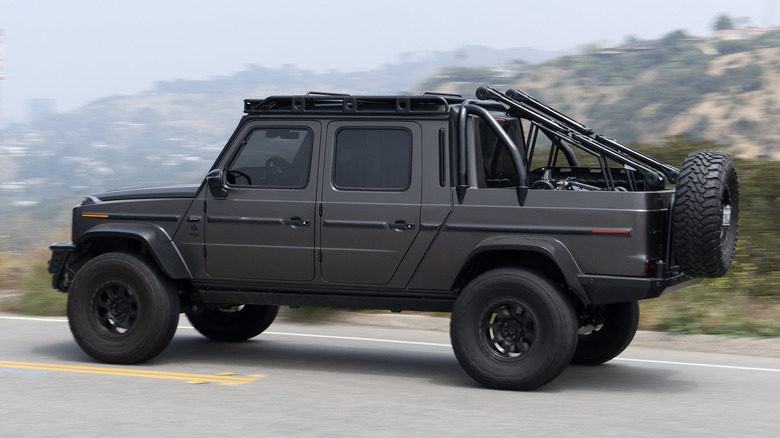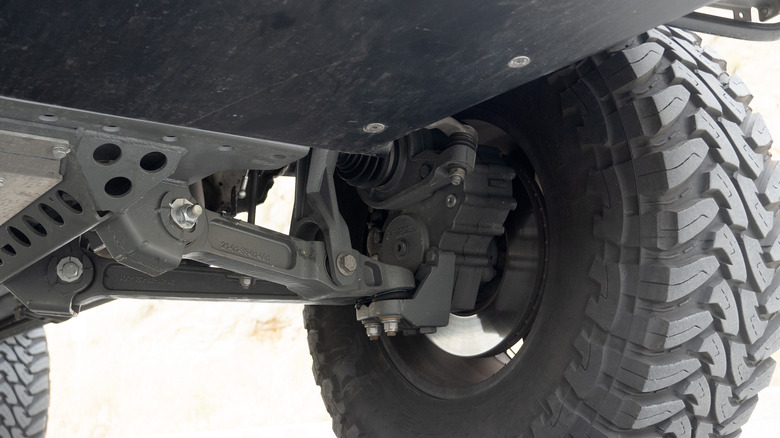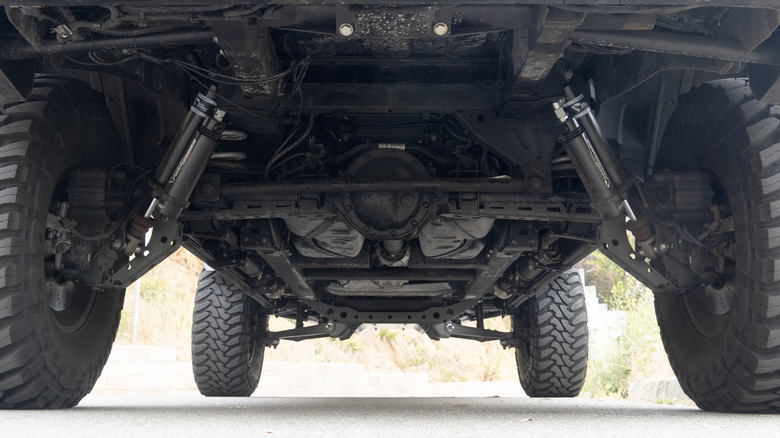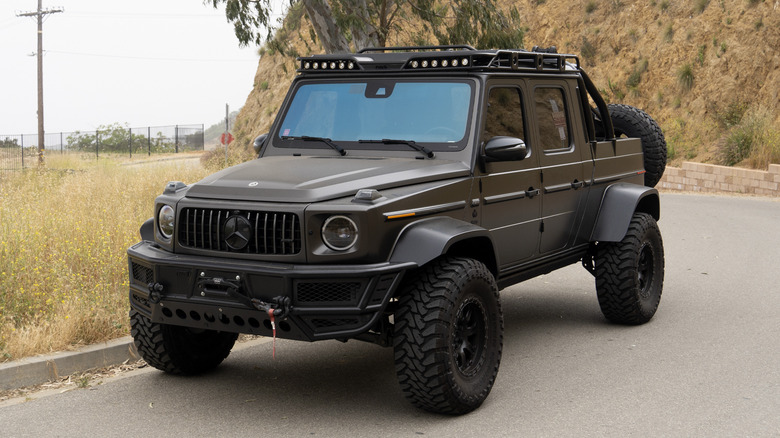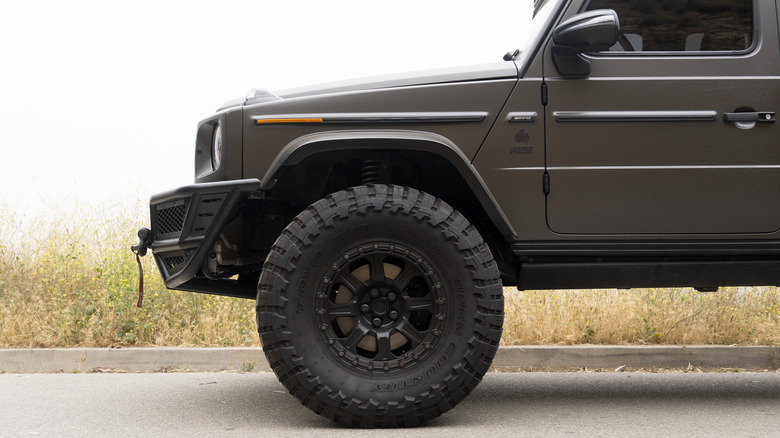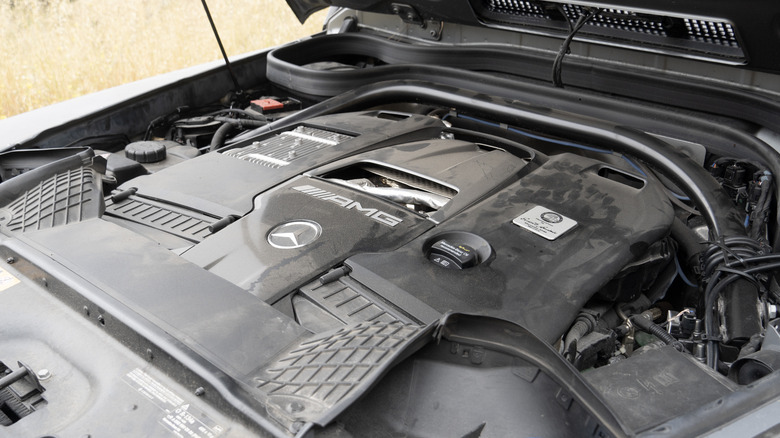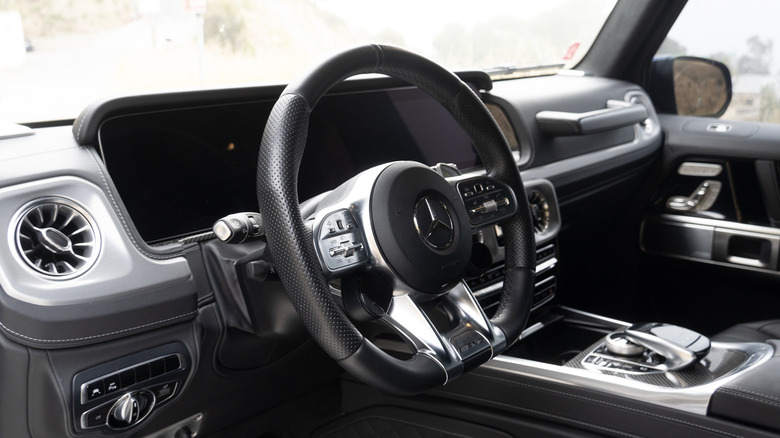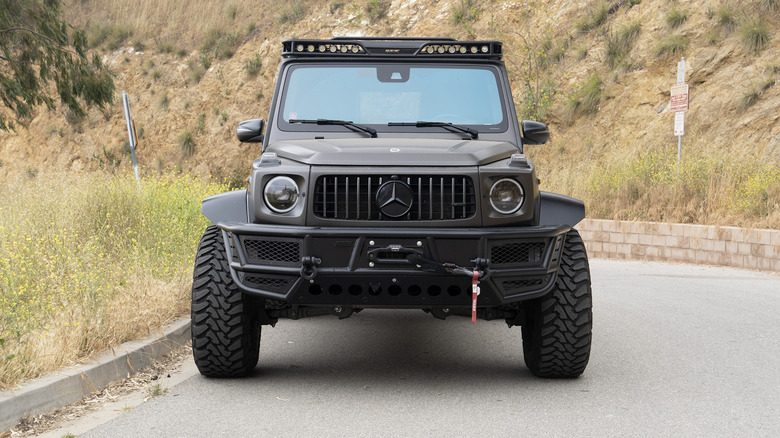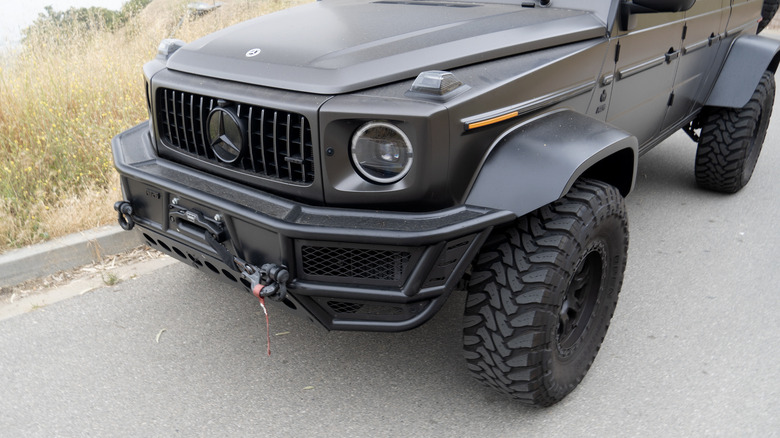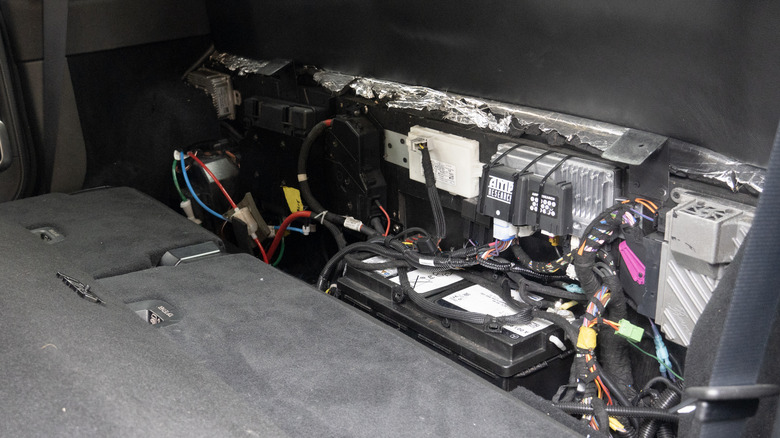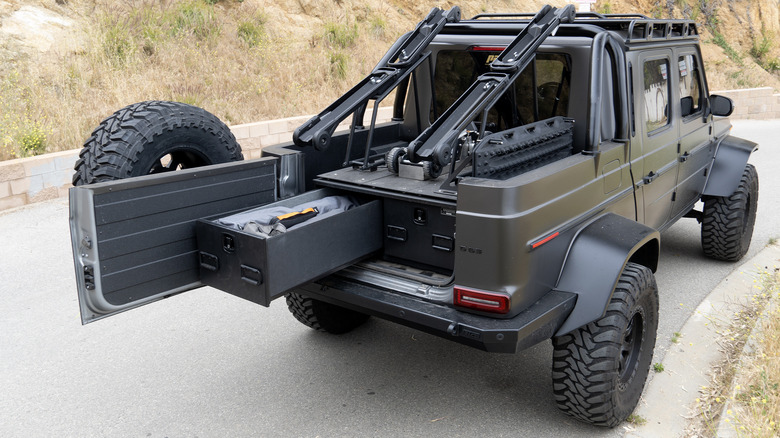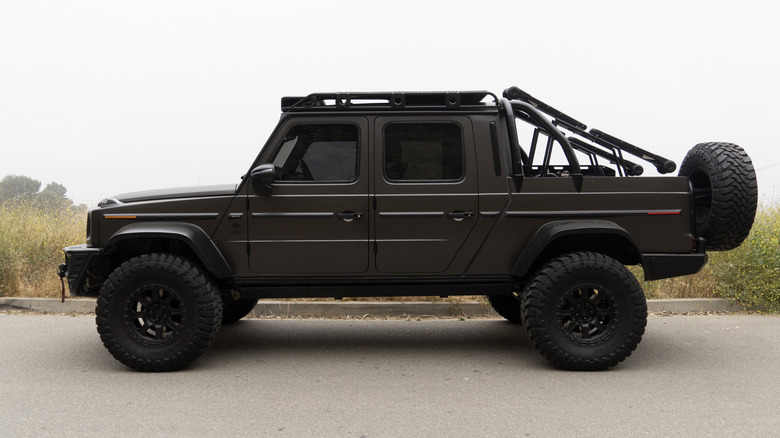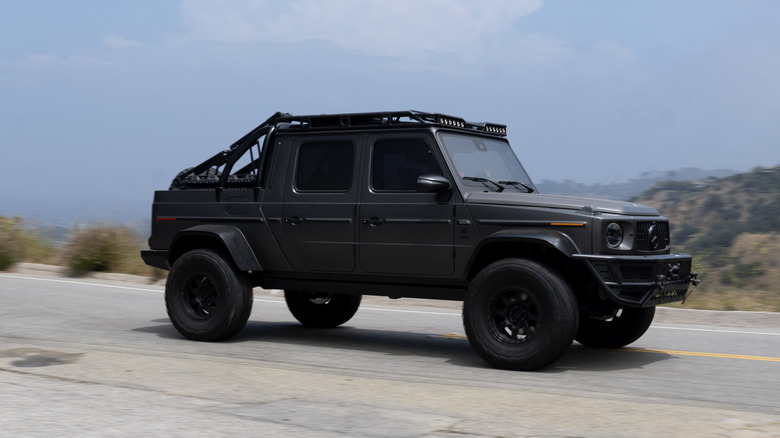This Wild G-Wagon Pickup Conversion Has The Crazy Axles All Serious Trucks Need
On the mean streets of Los Angeles, Mercedes-Benz's iconic G-Wagon long ago transitioned into a mainstream status symbol for the rich and famous. Seemingly around every corner, another boxy SUV with tinted windows hides influencers and celebs, taking up half of Rodeo Drive or crowding compact spots in the Whole Foods parking lot.
But once upon a time, the G-Wagon boasted true off-road cred, back when Benz first began selling a rugged military 4x4 built by Steyr-Puch. Mercedes-Benz still builds the G with that capability just begging to be unleashed, even if 99% of buyers will never actually hit any kind of dirt at any kind of speed. But with over 60,000 G-Wagons sold in the US since Benz first shipped the burly truck here in 2001, fractions of big numbers are still big numbers, after all—so a handful of aftermarket companies build hardcore off-roaders out of these German stalwarts today.
Pit26 Motorsports of Beverly Hills delivers the kind of custom G-Wagons that can bridge both worlds, with serious presence on city streets and serious chops in the deserts around the LA Basin. But Pit26's latest creation takes a big step past just a standard lift or a set of knobby tires—instead, the chassis has been chopped and stretched for a pickup bed conversion and then, most importantly, a set of portal axles installed to provide more ground and tire clearance simultaneously.
To prove the truck's bonafides, Pit26 founder Sammi Shaaya let me climb behind the wheel for a spirited run up and down Mulholland, including a long break to go over the engineering R&D behind the project.
What are portal axles?
For those wondering what, exactly, portal axles are and how they can add to an already monstrous G-Wagon build, rest assured that this simple system results in massive improvements to ground clearance and gearing. Essentially, installing portal axles takes a lift far beyond taller springs, longer shocks, and/or chassis spacers—depending on how you look at it, portal axles either drop the wheels or lift the entire vehicle by adding a simple gearbox to each wheel hub.
Now, the drive axles run well above the center of each wheel, as seen where the CV boots attach to the portal hub in the photo above. Installing portal axles allowed Shaaya to mount gargantuan 38-inch Toyo tires on this G-Wagon without sacrificing power or risking tire rub inside the wheel wells. And as anyone who has ever driven a lifted Jeep off-road can attest, every inch matters when it comes to tire size.
Mercedes uses portal axles from the factory
Of course, Mercedes-Benz knows all about portal axles and actually installed a similar setup on both the 4x4² and the completely absurd (and undeniably awesome) factory 6x6 versions. More historically significant, without a doubt, is the most famous factory vehicle to ever employ portal axles: the Unimog, arguably the most hardcore off-roader ever sold by an automotive OEM.
A Unimog might be able to lumber over just about any obstacle—and up to world-record heights in the Chilean Andes, to boot—but nobody would make the mistake of calling such a massive cab-over fast in any sense of the word. Not so for Pit26's portal-axle truck, which began life as a model year 2021 G63 AMG equipped with a twin-turbo 4.0-liter V8 pumping 577 horsepower and 627 lb-ft of torque through a nine-speed automatic transmission. Shaaya's background as a rock-crawling enthusiast shines through, but surprisingly, the portal axle's internal gearing also allow him to keep that sporty AMG spirit alive despite plenty of additional weight and bigger tires.
A passion turns into serious business
Shaaya's proclivities differentiate Pit26 from more typical Beverly Hills auto aficionados, who might own a couple of RS Porsches, a Ferrari or, more recently, a limited-edition McLaren. Instead, he learned to drive in an 80 Series Toyota Land Cruiser—which he actually reacquired later in life because he loved it so much.
But love for the Toyota itself doesn't quite explain why that 80 Series now sports an exposed roll cage with no roof, 40-inch tires, and mismatched body panel paint. He's taken the Land Cruiser on the Rubicon Trail and down to Baja California, and two different rollovers along the way taught Shaaya a lot about, you guessed it, rebuilding and modifying off-roaders. The battle-worn Toyota now waits for more fun in the garage while Shaaya harbors dreams of entering a G-Wagon in the Baja 500 or 1000.
Building a dream truck based on reality
That dream began manifesting back in 2015, when Shaaya first started building his own personal G-Wagon project. After all, imagine a dedicated off-roader who loves boxy solid-axle SUVs with plenty of articulation, power, and presence—but who can't buy the epic 4x4² version sold in Europe because Benz took years before committing to market something so aggressive in the US.
Instead of waiting or finding a gray market import loophole, Shaaya took matters into his own hands, but the truck we drove is actually for a client who experienced something similar after seeing a Brabus 800 XLP online, which was also not sold in the US. The project began in earnest in 2021, by which point Shaaya had already made a name for himself converting G-Wagons with portal axles swaps, so much so that he even sold kits separately from the builds themselves.
Newfound power, performance, and presence
This truck started life as a W463A, internal nomenclature that translates to a second-gen G with independent front suspension and rack-and-pinion steering (read: much more daily driveable, but slightly less hardcore than a solid-front-axle first-gen).
First things first, Pit26 chopped the G behind its C-pillar and stretched the frame just shy of 20 inches. Next, the truck received a set of portal axles from the Austrian manufacturer GForce Engineering. (Shaaya used to use and sell portals from Tibus Offroad but later switched to GForce.) He also further reduced the portal axles' gearing this time around, from 1.21 to 1.26 to compensate for the increased tire diameter's necessary drop in wheel torque.
Because the portal axles essentially re-gear the G, Pit26 can retain the stock twin-turbo V8 and transmission without fear of overloading componentry. Those factory ratings of 577 hp and 627 lb-ft of torque go out the window, though. We're now in the realm of real-world wheel-horsepower, as I learn almost immediately.
Re-gearing results in a remarkable response
Having previously driven plenty of built off-roaders with big tires and no revised gearing, I lean into the throttle perhaps too aggressively off the first red light—and almost launch straight over the intersection. A burbling exhaust lives up to the powerful potential of the driveline without too much fanfare, courtesy of a Magnaflow system that became necessary because the significantly higher ride made automatically retracting side steps something of a must-have.
Even before firing up the engine, though, just climbing up into Pit26's truck turns every drive into a ceremony. As we drove through Beverly Hills, we passed a couple of stock G-Wagon and laughed while looking down, literally, on their rooftops. But on the inside, the truck retains all the classic Mercedes-Benz creature comforts—cushy leather upholstery, brushed aluminum trim, a massive combined gauge cluster and infotainment display. Swaddled in luxury and pulling away from traffic (once I learned my lesson about throttle response), the truck actually feels surprisingly comfortable to drive, too, despite the obvious increase in size and scale.
Classic G-Wagon geometry, but with a twist
I attribute part of the ease that I found behind the wheel to Mercedes-Benz's stubborn refusal to excessively work over the second-gen G-Wagon's design, which means the new models still retain a narrow hood, in contrast to the oversquare front ends from Ram, Ford, Chevy, and even Toyota these days. Fender flares more akin to a Jeep or, dare I say, a 1990s Toyota or Mitsubishi help with viewing angles over the nose.
And out back, the G's upright windows provide a reasonable amount of visibility for changing lanes or navigating on tighter, twistier canyon roads. Now just imagine being able to see obstacles while off-roading, without needing a bevvy of different camera angles that inevitably turn off at the worst possible moment.
A surprise 6,000 miles of torture testing
As we drove up to Mulholland, Shaaya told me that when the first elements of this build wrapped up, his client picked the truck up and—entirely without warning—proceeded to promptly drive the truck over 6,000 miles round trip to Wyoming and Montana. Talk about unexpected torture testing, but a great opportunity for Pit26 to learn from any potential concerns that cropped up.
Shaaya mentioned that after the road trip, he focused more on the control arms and steering knuckles, which do deal with more load when using portal axles as part and parcel of the independent front suspension system—that same IFS that makes the second-gen G so much more comfortable to drive on that exact kind of a 6,000-mile road trip.
So far, the unnamed client and Shaaya (and now me) have together racked up over 10,000 miles on the build. Even at a full foot wider than stock, the truck barely clunks and rattles—other than a few retorts over larger bumps from the TruckVault drawers and bike rack setup in the bed. Part of the smooth ride comes, no doubt, from the tall sidewalls of 38-inch Toyos mounted on 18-inch wheels, but also the 2.65-inch Bilstein shocks that are actually beefier than a factory 4x4².
Small wheels, big tires, and lots of electronics
Hold on, only 18-inch wheels? Yep, this client shares the same preferences as Shaaya and myself when it comes to mounting bigger tires on smaller wheels. The client's choice of 18-inch wheels results in the extra track width—Shaaya's other builds would add 4.5 inches per side, or nine inches total—and also required swapping on a set of G550 brakes, rather than the larger AMG units, but braking power feels surprisingly unfazed—probably thanks again to the gearing.
Even the automatically inflating seat bolsters still hugged my torso during hard cornering. That's no small feat, Shaaya proved by pulling the backseat's seatback forward to reveal that the G-Wagon leaves the factory with a grand total of 72 different computers that control all the important electrical components (think the airbag ECU, battery regulation, the seat bolsters and adjustments, plus now those automatic steps and aftermarket stereo amplifier).
Lasting impressions of a portal-axle G-Wagon
Hustling along Mulholland in a massive matte gray G-Wagon, traffic around us slows down a bit to stare. To be fair, the dark gray looks closer to black on a cloudy day. And the murdered-out wheels, tinted windows, and black racks in back all complement the stereotypical Beverly Hills G-Wagon aesthetic. Only this one is more, in every way, especially for those enthusiasts who might actually take a peek underneath at all the custom suspension components, skid plates, bumpers, and of course, the portal axles.
The massive mud terrains don't even create too much road noise, as a testament to Mercedes-Benz's sound deadening in what has become, undoubtedly, a peak luxury vehicle. (The Magnaflow exhaust and my enthusiastic right foot might have helped drown out the hum of rubber, too.) After the hard launch, hammering the throttle at speed brings up respectable, if not breathtaking, acceleration well past 70 miles per hour. I asked Shaaya how much the truck weighs, all in, but he hasn't taken it to a scale yet. And don't ask about fuel economy, which I'd guess is now in the mid-single digits.
No project car ever reaches true completion and Shaaya knows that even 1,100 hours into this build, he can still perfect the recipe. Personally, I would want a slightly better turning radius, less of a four-door short-bed layout, and softer suspension. But the realities of modifying and then daily driving a custom conversion like this dictate every decision along the way, especially after the portal axles.
Next steps for Pit26's G-Wagon program
The main disadvantage of portal axles is unsprung weight: each adds 80 pounds to each wheel hub. Plus, the bigger tires and beefed-up bumpers, skids, and suspension components all sit well beneath the cabin level. Understeer understandably adds up the faster I enter corners and despite minimal body roll, a planted wheelbase somehow translates to a bit of an "up here and down there" feeling as two centers of mass react to each other.
But I write this fully aware that I'm talking about hard cornering in a massive, lifted, stretched G-Wagon. If Shaaya wants to take a G-Wagon to Baja and win a race in any class, then more suspension travel, more tire clearance, and more damping without portals will almost certainly enter the mix. Current plans to boost output to 1,1000 horsepower, relocating the intercoolers to allow for bigger wheel and tire combos, and further torture testing for the custom suspension components should help.
G-Wagons in their natural habitat
Take a look at any trophy truck and clearly, unsprung weight is not great for blasting through whoops, silty ruts, and avoiding flats in some of the most treacherous terrain on the planet. Shaaya knows all this, which gives me hope. And in the meantime, short of racing in Mexico, he's found the perfect client who thankfully comprehends what building just about the most hardcore G-Wagon possible requires.
Short of showy carbon-fiber body panels or underbody lights or jumbo twin-turbos spitting fire through straight-piped exhaust, that's where 1,100 man-hours dedicated to real engineering development gets you—right up to the top of Mulholland, lickety-split. But the desert beckons from over the mountains, where this G-Wagon would truly shine.
